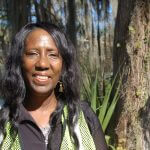Gretchen Rank
Mancos, Colorado
For the past six years Gretchen has served as the Executive Director of the Mancos Conservation District in southwest Colorado. In addition, Gretchen has twenty-five years of experience in financial administration and office management for a variety of businesses, nonprofits, and government entities. As a longtime subsistence farmer and maintaining 35 acres of dry land hay, Gretchen has an appreciation for water and soil conservation techniques and a deep understanding of the importance of water and the complexities surrounding water rights.
Tell me more about how you got into stream management planning in Colorado.
I have a background in finance and applied over six years ago to work part-time for the Mancos Conservation District to manage their books. Actually, the night before my interview I googled what a conservation district is! I was very intrigued about how conservation districts came to be and how they were developed out of the Dust Bowl. I also liked that they were a voluntary organization and not a regulatory agency, so we get to work with landowners to do amazing things. I loved that idea. As part of that job I attended monthly board meetings to present on finances and take minutes. Each month, my board would challenge me with something new, so I would say “sure, let’s try it.” I didn’t have experience or an educational background in conservation or natural resources, so I had to grow into this role. It’s incredible the amount that I’ve learned in six years!
At the time my family and I ran our own subsistence farm. We grew the majority of the vegetables and poultry that we ate as a family and did that for about 10 years. I come from a family of agricultural producers during the Dust Bowl in Iowa, so [agriculture] was certainly in my blood. And so, as my board challenged me with these different tasks and as landowners came in, they started to recognize the district as a resource. It’s exciting for me to see things come together. I just fell in love with this work, and I find it really fun and exciting.
I was talking to a group last week and presenting on the Mancos Stream Management Plan and some of the recreational opportunities we’re looking at providing in town, and it just hit me how I have this connection and love for the Mancos River and all of its tributaries. I think that’s also caused me to broaden my scope of work and grow my love for the land, the river, and the landowners.
What keeps you motivated in this work?
When it gets really tough I have to think about how we’re making a difference. Especially during a historic drought, I worry about whether this work is making a difference. It’s usually a couple of my board members, a landowner and my husband that come along and remind me that it is. Having champions to cheer me on keeps me moving forward. I also have an incredible team of partners that are dedicated to this work and their passion, assistance, and expertise has been invaluable in keeping the work moving forward. I guess I also have always loved puzzles and similar games and so a lot of times when things get tough I love to come back and problem solve and think “okay, well this is just another piece of the puzzle.” I’ll also say that my board is very supportive of me taking time off and pursuing the things that I love to do, so that’s been really helpful too.
You’ve been a leader for the Mancos Stream Management Plan, can you tell me more about why it was important for you to involve the agriculture community in the development of this plan?
When I first started, I had never heard of stream management planning, and a lot of the work that we were focused on initially was more on water quality and quantity. We were working on water quality sampling and some of our tributaries that have impairments. We were also working on water efficiency systems, piping of ditches, and some of the diversion structure improvements. We were able to put in permanent structures so an irrigator wasn’t in the channel rebuilding the structure multiple times per year. Our river has high variability, so once completed, they could then divert during low flow and high flow. That was the first project that I worked on that had this incredible agricultural benefit, but also an environmental benefit because we worked with multiple partners on the designs to include structures for fish passage. The diversions were probably the first projects that I worked on that had an incredible long-term agricultural and environmental benefit. I was really intrigued by that.
I started to get more involved with the Mancos Watershed Group and a stream management plan (SMP) started to come up and be discussed. At the same time we started to see a lot of gaps in information specific to the health and flow of the Mancos River. Once we started to learn what could all be covered in an SMP my board came back super excited and wanted [the Mancos Conservation District] to lead it. We’re the organization that helps with these voluntary projects and already had established relationships with agriculture producers and water right holders. So we took this to the larger watershed group and they agreed that we should be the lead for the SMP.
What was it like to work with landowners in the development of this plan?
We knew that in order to come up with a strong stream management plan it was going to have to deal with water management. Management of the reservoir and management of our irrigation systems and diversion structures. We knew that if we were going to move forward with an SMP that agriculture would have to be involved because they hold a majority of the water rights and one of our number one goals is to protect existing water rights and uses. We talked a lot about how we start to look at management options, so we knew we had to go to the agricultural community to learn what’s working and what’s not working, and what were their ideas for solutions. We contracted with a local rancher, who has an understanding of the working of the hydrology, water management, and the watershed, to help us better understand some of the opportunities, but to also act as a liaison for the agricultural community. We always want to be clear that our agriculture consultant doesn’t speak for the agricultural community, but he acts as a conduit. He is able to attend meetings, take that information to the agricultural community for feedback and then bring it back to the Watershed Group. With his help we’ve been able to have a lot of meaningful conversations with producers and an open and transparent process, it also allowed us to create a plan that’s usable. We didn’t want to move forward and create an SMP that was just another a book on the shelf. We’re facing serious drought and historic water challenges, so we have to have a plan that is usable and that’s also reflective of the values within our community.
This interview took place on June 16, 2021. Learn more about Gretchen’s work.







